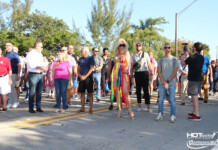If there is a woman who will go down in history for making a legal landmark victory for the LGBT community, that is Edith “Edie” Windsor. How can we forget that iconic photo of Edie coming out of the Supreme Court with opened arms after SCOTUS’ Justice Kennedy delivered the opinion of the Court, which ruled in her favor of her declaring the 1996 Defense of Marriage Act unconstitutional, forcing the federal government to recognize same-sex marriages. This was also a tremendous personal achievement for Windsor.
Edith Windsor was born and raised in Philadelphia in 1929 to Russian immigrants, James and Celia Schlain. She graduated from Temple University in 1950. She received a master’s degree in mathematics from New York University and studied applied mathematics at Harvard University. She was a pioneer in computer architecture and operating systems; later on became a technology manager at IBM. In May 1951, Edith married her brother’s best friend, Saul Windsor, for a brief time as she felt in love with a woman.
Years later, in 1963, Edith S. Windsor met Dr. Thea Clara Spyer—a clinical psychologist—at Portofino, an Italian restaurant in the South. They began a relationship in 1965 and in the summer of 1967, Thea proposed to Edie with a diamond pin which you may have seen Edie wear during and after her case was in court. They were among the first couples to get a domestic partnership in New York City in 1993 and married in Toronto, Canada in 2007. Their marriage was recognized in New York where they lived until Thea’s death in 2009, they were together for 44 years.
When Thea died, Edie was the executor and beneficiary of her state, but the federal government didn’t recognize their marriage and taxes needed to be paid. Edie had to pay nearly $363,053 in federal estate taxes (later returned with interest by the IRS). According to New York ACLU, “Due to DOMA’s discriminatory policies, Windsor was not able to claim the estate tax marital deduction that is available when the surviving spouse is of the opposite sex.” Edie filed the lawsuit against the federal government on Nov. 9, 2010, for refusing to recognize their marriage, winning multiple legal challenges that led to the 2013 Supreme Court. The case was United States v. Windsor, argued by Roberta Kaplan and Andrew Ehrlich. The case was argued on March 27, 2013, and decided June 26, 2013. That same year, 2013, Edie was third Runner-up Person of the Year by Time Magazine.
Edith’s victory came two years before another landmark victory, Obergefell v. Hodges, where the Supreme Court recognized gay marriage as constitutional nationwide on June 26, 2015, with all the protections and privileges of heterosexual couples. The rest is now part of humanity and the LGBT History.
This month marks the 6th anniversary of Edie’s passing, September 12, 2017, in Manhattan, NY. She was 88. By her side was her second wife, Judith Kasen-Windsor, a banking executive and LGBT activist. On September 26, 2016, Kasen-Windsor married Edie Windsor at New York City Hall. They met in 2015 while both participating in their mutual passion for LGBTQ activism. Judith now is now making sure the Edie Windsor & Thea Spyer Foundation’s legacy lives on.
Visit ediewindsor.org to learn more about The Edie Windsor Healthcare Center, The Edie Windsor Visitor Center at Hetrick-Martin Institute, The Thea Spyer Center at Callen-Lorde Community Health Center, The Edie Windsor SAGE Center for LGBTQ+ Seniors, Edie Windsor & Thea Spyer Coffee Shop at The Center in NYC and Lesbians Who Tech Edie Windsor Coding Scholarship.
“The defeat of DOMA Section 3…removes an explicit discriminatory injustice. It ended the ‘second-class status’ of my legal marriage and that of all same-sex couples. It brought the word ‘dignity’ into our lives in this most important situation.”
—Edith Windsor, She Magazine Interview, Jan 2014.
Her memoir was first published in October 2019.
Source: nyclgbtsites.org, Time Magazine, NYACLU, Wikipedia.















